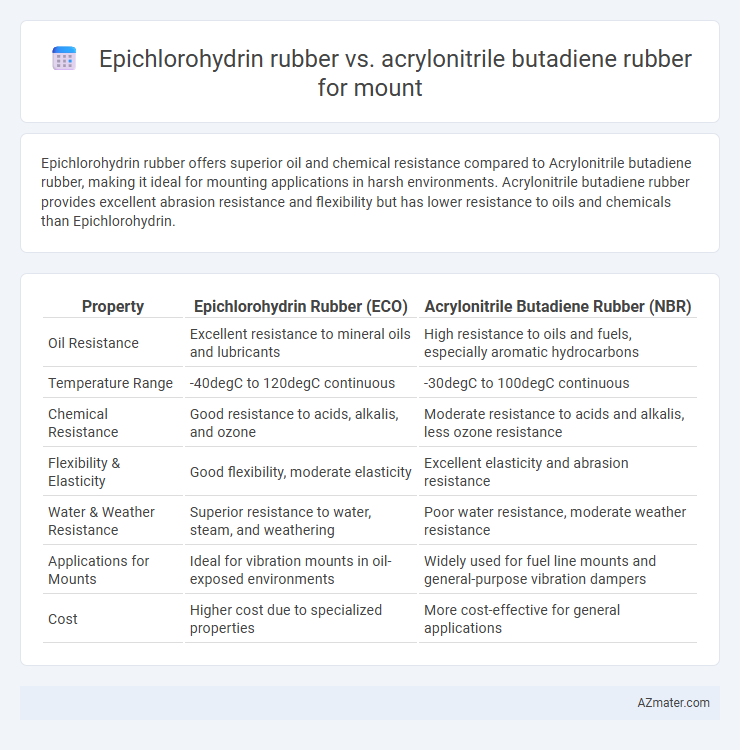Epichlorohydrin rubber offers superior oil and chemical resistance compared to Acrylonitrile butadiene rubber, making it ideal for mounting applications in harsh environments. Acrylonitrile butadiene rubber provides excellent abrasion resistance and flexibility but has lower resistance to oils and chemicals than Epichlorohydrin.
Table of Comparison
| Property | Epichlorohydrin Rubber (ECO) | Acrylonitrile Butadiene Rubber (NBR) |
|---|---|---|
| Oil Resistance | Excellent resistance to mineral oils and lubricants | High resistance to oils and fuels, especially aromatic hydrocarbons |
| Temperature Range | -40degC to 120degC continuous | -30degC to 100degC continuous |
| Chemical Resistance | Good resistance to acids, alkalis, and ozone | Moderate resistance to acids and alkalis, less ozone resistance |
| Flexibility & Elasticity | Good flexibility, moderate elasticity | Excellent elasticity and abrasion resistance |
| Water & Weather Resistance | Superior resistance to water, steam, and weathering | Poor water resistance, moderate weather resistance |
| Applications for Mounts | Ideal for vibration mounts in oil-exposed environments | Widely used for fuel line mounts and general-purpose vibration dampers |
| Cost | Higher cost due to specialized properties | More cost-effective for general applications |
Introduction to Mount Rubber Requirements
Mount rubber requires high durability, chemical resistance, and excellent mechanical strength to withstand operational stresses in industrial applications. Epichlorohydrin rubber (ECO) offers superior oil, fuel, and ozone resistance, making it ideal for dynamic sealing in harsh environments. Acrylonitrile butadiene rubber (NBR) provides excellent resistance to oils and fuels but has lower ozone and weather resistance compared to ECO, which impacts its suitability for outdoor or high-temperature mount conditions.
Overview of Epichlorohydrin Rubber (ECO)
Epichlorohydrin rubber (ECO) is a synthetic elastomer known for its excellent resistance to oil, fuel, ozone, and weathering, making it ideal for mounting applications requiring durability under harsh chemical exposure. ECO exhibits superior impermeability to gases and liquids compared to acrylonitrile butadiene rubber (NBR), with better low-temperature flexibility and heat resistance up to 150degC. Its unique balance of chemical resistance, mechanical strength, and elasticity often makes it the preferred choice for mounts used in automotive and industrial settings where exposure to oils and fuels is common.
Overview of Acrylonitrile Butadiene Rubber (NBR)
Acrylonitrile Butadiene Rubber (NBR) is a synthetic elastomer known for its excellent resistance to oil, fuels, and chemicals, making it ideal for industrial mounts exposed to harsh environments. Compared to Epichlorohydrin rubber, NBR offers superior abrasion resistance and mechanical strength, enhancing durability under dynamic load conditions. Its high tensile strength and low gas permeability also contribute to the reliable performance of mounts in automotive and aerospace applications.
Mechanical Properties: Strength and Flexibility
Epichlorohydrin rubber exhibits superior oil resistance and excellent flexibility with tensile strength typically ranging from 10 to 20 MPa, making it ideal for mounts requiring long-term durability under chemical exposure. Acrylonitrile butadiene rubber (NBR) offers higher tensile strength, often between 15 and 25 MPa, and excellent abrasion resistance but generally less flexibility than epichlorohydrin. For mechanical mounts, Epichlorohydrin rubber balances strength and flexibility better under harsh environmental conditions, whereas NBR is preferred for applications needing enhanced wear resistance and higher mechanical load capacity.
Chemical Resistance and Environmental Durability
Epichlorohydrin rubber (ECO) exhibits superior chemical resistance against oils, fuels, and ozone compared to Acrylonitrile butadiene rubber (NBR), making it ideal for mounts exposed to harsh chemical environments. ECO also offers excellent environmental durability, including resistance to heat aging, weathering, and UV radiation, enhancing mount longevity in outdoor and automotive applications. While NBR performs well in oil resistance, its lower ozone and weather resistance limits its effectiveness in prolonged environmental exposure compared to Epichlorohydrin rubber.
Temperature Performance and Heat Aging
Epichlorohydrin rubber (ECO) exhibits superior temperature performance compared to Acrylonitrile butadiene rubber (NBR), maintaining flexibility and mechanical properties in a wider temperature range from -40degC to 120degC. ECO demonstrates excellent heat aging resistance with minimal hardness increase and tensile strength loss after prolonged exposure to temperatures around 120degC, making it ideal for harsh thermal environments. In contrast, NBR typically shows reduced heat aging stability above 100degC, leading to faster degradation and embrittlement under sustained heat exposure.
Compression Set and Long-Term Stability
Epichlorohydrin rubber (ECO) offers superior compression set performance and enhanced long-term stability compared to acrylonitrile butadiene rubber (NBR) in mounting applications. ECO exhibits excellent resistance to ozone, weathering, and oil exposure, maintaining dimensional stability and elasticity over extended periods under compression. NBR, while providing good resistance to oils and fuels, tends to have higher compression set values and reduced durability in prolonged mechanical stress environments.
Cost-Effectiveness and Availability
Epichlorohydrin rubber offers superior chemical resistance and flexibility for mounts but generally comes at a higher cost due to specialized production processes. Acrylonitrile butadiene rubber (NBR) provides a more cost-effective solution with widespread availability and good oil and abrasion resistance, making it suitable for many standard mount applications. Choosing between these materials depends on balancing budget constraints with the specific performance demands of the mounting environment.
Typical Applications for ECO and NBR in Mounts
Epichlorohydrin (ECO) rubber excels in mounts requiring excellent oil resistance, weatherability, and ozone resistance, making it ideal for automotive engine mounts and industrial vibration isolators exposed to harsh environments. Acrylonitrile butadiene rubber (NBR) is favored for mounts in fuel systems, hydraulic applications, and machinery requiring superior resistance to petroleum-based fluids and abrasion. Mounts made from ECO provide enhanced durability in cold weather and chemical exposure, while NBR mounts offer reliable performance under continuous exposure to oils and fuels.
Conclusion: Choosing the Right Rubber for Mount Applications
Epichlorohydrin rubber offers superior chemical resistance and flexibility, making it ideal for mounts exposed to oils, fuels, and extreme temperatures. Acrylonitrile butadiene rubber (NBR) excels in abrasion resistance and tensile strength, suitable for mounts requiring durability in mechanical or hydraulic environments. Selecting the right rubber depends on specific operational conditions such as exposure to chemicals, temperature range, and mechanical stress, ensuring optimal performance and longevity in mount applications.

Infographic: Epichlorohydrin rubber vs Acrylonitrile butadiene rubber for Mount
 azmater.com
azmater.com